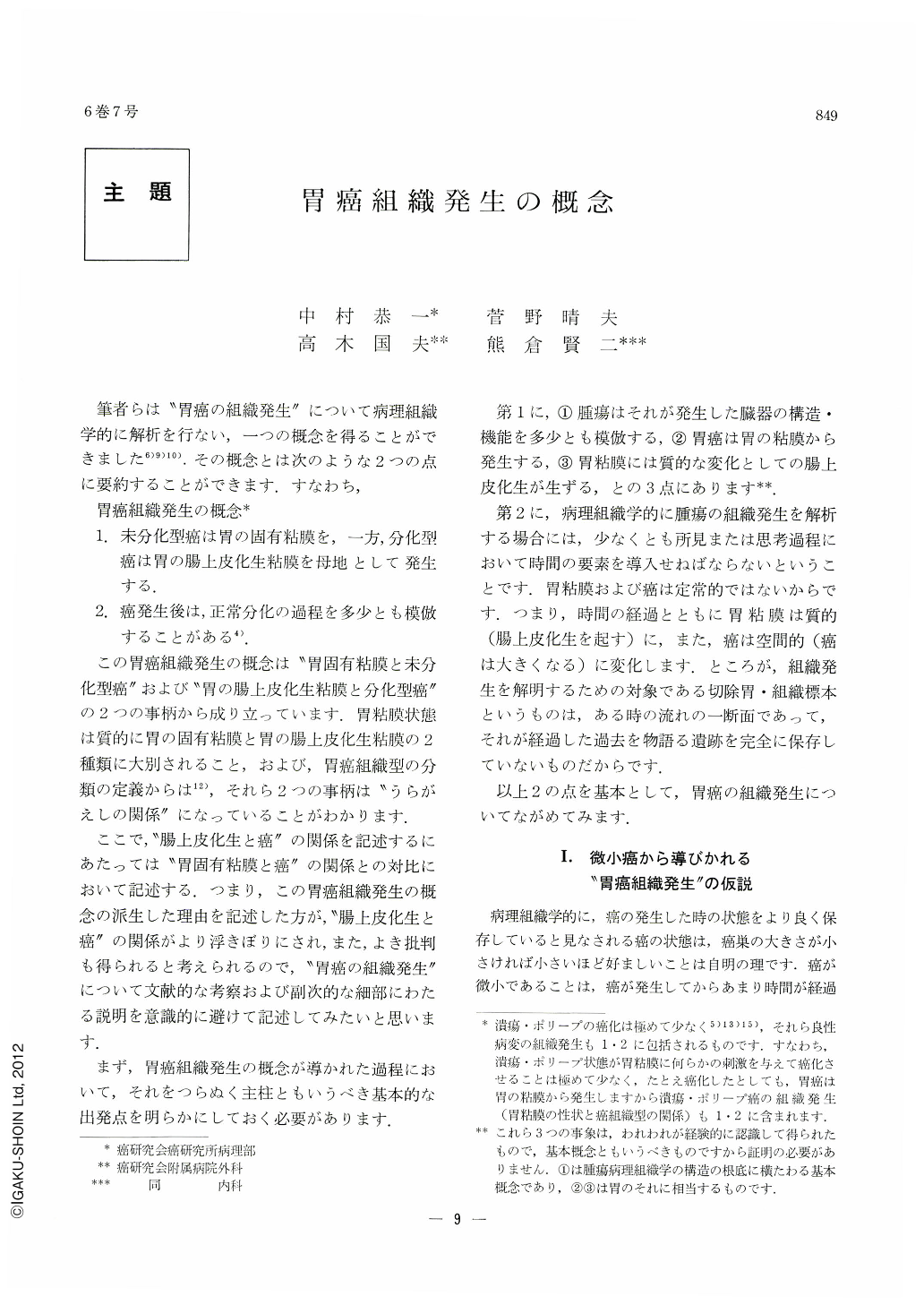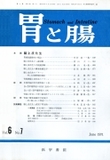Japanese
English
- 有料閲覧
- Abstract 文献概要
- 1ページ目 Look Inside
- サイト内被引用 Cited by
筆者らは“胃癌の組織発生”について病理組織学的に解析を行ない,一つの概念を得ることができました6)9)10).その概念とは次のような2つの点に要約することができます.すなわち,
胃癌組織発生の概念*
1.未分化型癌は胃の固有粘膜を,一方,分化型癌は胃の腸上皮化生粘膜を母地として発生する.
2.癌発生後は,正常分化の過程を多少とも模倣することがある4).
Hitherto histogenesis of gastric carcinoma has been discussed for the most part in connection with ulcer, polyp and so-called gastritis. However, frequency of carcinoma developing from these benign lesions is variable in the literature. If benign lesions are of precancerous conditions in causal relation with cancer, a certain approximation should at least be found in the incidence of these cancers, because causality naturally involes possibility.
Because of the above-mentioned inconsistency, we have previously studied the relationship between benign lesions and carcinoma, and obtained the conclusion that ulcer-carcinoma and polypogenic carcinoma are only of rare occurrence among all varieties of gastric cancer (5, 11, 13 and 15). Consequently, it may fairly be presumed that the majority of gastric carcinoma develop either in the normal gastric mucosa or from so-called gastritis, quite independently of any localized lesion.
In order to verify this presumption, seventy lesions of microcarcinoma less than 5 mm in the greatest diameter, discovered by through-serial cutting of the whole stomach, were histologically examined. Undifferentiated carcinomas, such as adenocarcinoma mucocellulare et scirrhosum, were completely surrounded with the pyloric gland mucosa, its cells similar to those of the foveolar epithelium or of the pyloric gland which produce mucin and has no striated border. Contrariwise, the majority of differentiated carcinoma, such as adenocarcinoma tubulare et papillotubulare, were encircled by the intestinalized mucosa, its cells closely resembling those of the intestial mucosa which naturally does not secrets mucin but has striated border.
On the basis of these findings, we have draw the following hypothesis: Undifferentiated carcinoma develops from the proper mucosa of the stomach consisting of the pyloric and fundic gland mucosae while differentiated carcinoma does from the gastric mucosa that has undergone intestinal metaplasia.
Upon this hypothesis, we have then examined carcinomas of ordinary dimensions more usually encountered, obtaining the following data:
1. Intramucosal carcinomas seen in resected stomach show a significant relationship between their histological types and the degree of mucosal intestinalization. In those stomachs with milder intestinal metaplasia, undifferentiated carcinoma is more frequently encountered than differentiated one, while in those with more severe intestinal metaplasia it is quite the reverse. These differences are statistically highly significant.
2. In advanced carcinomas, the ratio of undifferentiated carcinoma to differentiated one diminishes with increasing age. In stomachs removed for benign ulcer, the ratio of mild intestinal metaplasia to severe one decreases with increasing age. The ratio of histological type of carcinoma is thus in direct correlation to that of the severity of intestinal metaplasia.
3. All carcinomas completely surrounded with the fundic gland mucosa were histologically of undifferentiated type (Table 8).
4. Cells of undifferentiated carcinomas are electronmicroscopically similar to those of the foveolar epithelium or the pyloric gland having mucin droplets and poor microvilli (Table 9), as are cells of differentiated carcinomas to those of the intestinal epithelium with well-developed microvilli forming striated border but with no mucin droplets (Table 10).
As is apparent from the above, the hypothesis thus drawn is not contradictory in carcinomas of ordinary size, so that we are justified in saying that the hypothesis established in behaviors of rnicrocarcinomas can be interpreted as a conception of histogenesis of gastric carcinoma.
The conception fits in well with clinico-pathological behaviors of cancer generally known: Undifferentiated carcinoma is more frequent in the young, while differentiated carcinoma is more common in the old. As to cancer growth, the undifferentiated is diffusely infiltative and grossly shows Borrmann Ⅳ or Ⅲ type, while the differentiated is expansive and shows Borrmann Ⅱ or Ⅰ type. Peritoneal dissemination occurs in the undifferentiated, but it does not in the differentiated.

Copyright © 1971, Igaku-Shoin Ltd. All rights reserved.


